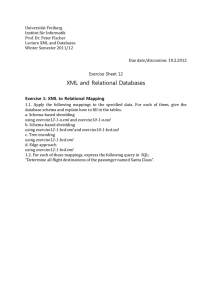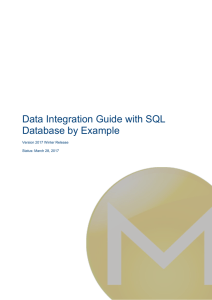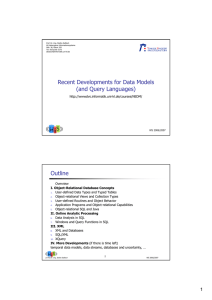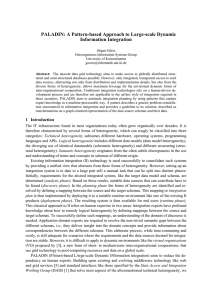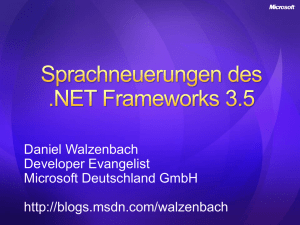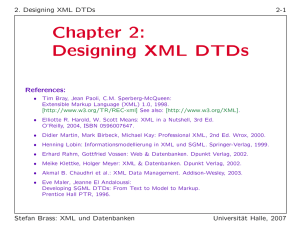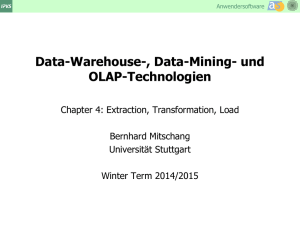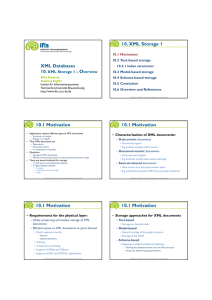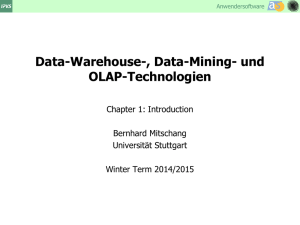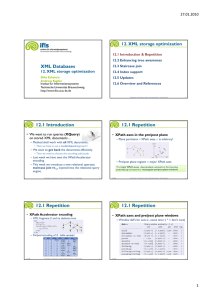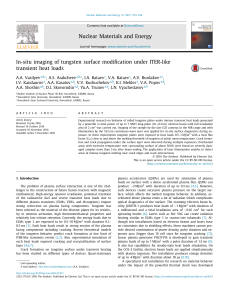Learned love - Emblem Project Utrecht
Werbung
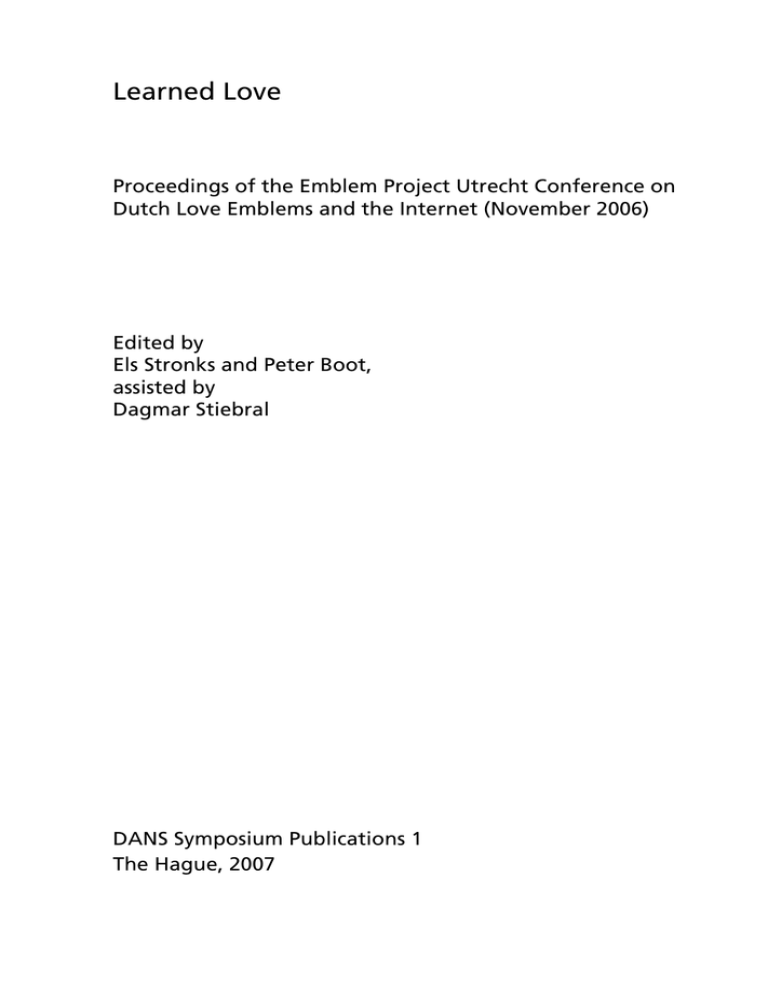
Learned Love Proceedings of the Emblem Project Utrecht Conference on Dutch Love Emblems and the Internet (November 2006) Edited by Els Stronks and Peter Boot, assisted by Dagmar Stiebral DANS Symposium Publications 1 The Hague, 2007 archiveren van digitaal academisch erfgoed iii Contents The Dutch love emblem on the Internet: an introduction – Els Stronks and Peter Boot 1 Part 1 The Dutch love emblem Creator of the earliest collection of love emblems? – Alison Saunders 13 Commonplaces of Catholic love – Arnoud Visser 33 Encoding the emblematic tradition of love – Marc van Vaeck 49 Churches as indicators of a larger phenomenon – Els Stronks 73 The Spanish epigrams in Vaenius’s Amoris divini emblemata – Sagrario López Poza 93 Love emblems and a web of intertextuality – Jan Bloemendal 111 The Ambacht van Cupido from 1615 in Wroclaw (Poland) – Stefan Kiedron and Joanna Skubisz 119 Investing in your relationship – Arie Jan Gelderblom 131 The love emblem applied – Peter Boot 143 Part 2 The digitisation of the emblem The Emblem Project Utrecht as a knowledge site – Els Stronks 151 Traditional editorial standards and the digital edition – Edward Vanhoutte 157 The technical backbone of the Emblem Project Utrecht – Johan Tilstra 175 Digitising Dutch love emblems – Peter M. Daly 183 Setting the emblem schema to work – Thomas Stäcker 201 Mesotext. Framing and exploring annotations – Peter Boot 211 Colour plates Setting the emblem schema to work Thomas Stäcker, Herzog August Bibliothek Wolfenbüttel Research on emblem books and emblems has profited greatly from the digitisation and web presentation of source materials. The University of Illinois (hosting the OpenEmblem Portal), the University of Glasgow, the University of Munich, the Emblem Project Utrecht of the University of Utrecht, the Mnemosyne Project, the University of A Coruña, the Duke August Library, to name just a few, have put selections from emblem collections online, meaning that they can be searched and accessed much easily than before. Although digitisation and presentation of substantial parts of digitised emblems on the web has made great progress and tremendously enlarged the scope and range of material available at our fingertips, the user and researcher still cannot be satisfied with the fact that resources are scattered all over the web. Obviously, one of the great challenges of future digital emblem research and digital humanities in general is to achieve more integrated systems which group resources together, making them available through uniformly designed graphical interfaces and allowing searches on standardized fields and vocabulary. This process can be long and tedious as there are not only technical obstacles to be overcome but also content-related, political, institutional and funding issues to be solved. After the recent completion of new emblem projects such as those in Glasgow and Utrecht the question of integration once again comes to the fore. Would it not be helpful if one could search all the data available simultaneously and check what books or other emblematic material has already been digitised? Or would it not be advantageous to have a joint index list of mottoes, subscriptions or a common browser for Iconclass notations describing all picturae available on the web? No doubt, this would be a very welcome prospect. However, since each project in the field serves its own particular requirements and styles its particular rules to suit its own needs best, accumulating data is made very difficult. The OpenEmblem Group, therefore, agreed on the development of a shared standard to exchange data. Stephen Rawles’s so-called ‘spine of information’ (Rawles 2004), an abstract description of the components an emblem metadata record should contain, laid the foundation for further development of technical tools allowing for more integrated accesses http://images.library.uiuc.edu/projects/emblems/ (All URL’s last viewed at the end of 2006) http://media.library.uiuc.edu/projects/oebp/ http://www.ces.arts.gla.ac.uk/html/AHRBProject.htm http://mdz1.bib-bvb.de/~emblem/ http://emblems.let.uu.nl/emblems/html/index.html http://www.mnemosyne.org/about/projects/emblems http://rosalia.dc.fi.udc.es/emblematica/ http://www.hab.de/forschung/projekte/emblematica-e.htm Thomas Stäcker 201 -- <emblem citeNo=“1“ xlink:href=“http://diglib.hab.de/drucke/xb-6550/start.htm?image=00027“ page=“8v“> - <motti> - <transcription xml:lang=“de“ xlink:href=“http://diglib.hab.de/drucke/xb-6550/start.htm?image=00027“ page=“8v“> Das Jungste Gericht. <normalisation xml:lang=”de”>Das jüngste Gericht</normalisation> </transcription> <transcription xml:lang=“la“ xlink:href=“http://diglib.hab.de/drucke/xb-6550/start.htm?image=00028“ page=“9r“>lud <translation xml:lang=”en”>The last judgement</translation> </motti> Fig. 1: Demonstration of the validation process Fig. 2: Demonstration of an error message and harmonization of data. The next step consisted in the conversion of this description into a formal XML-based set of rules. Wolfenbüttel accomplished this by designing an XML-schema, now available on the Wolfenbüttel Emblematica Online project web page. In addition, an easy-to-use web interface was set up, allowing everybody to check the validity of his or her XML documents against the schema. In a technical sense the ‘spine’ is set to work by the schema in as much as it enforces the spine’s rules on a document in an XML environment. For the validation the Saxon parser10 was used, one of best parsers currently available. To demonstrate the validation process, one may assume that in an XML the tag ‘motti’ is mistakenly used for ‘motto’ (Fig. 1). When checking this against the schema you will receive an error message (Fig. 2). One might ask, why do we need such a schema? Setting the schema to work means more than applying pre-defined rules to XML examples. The main purpose of the schema is to provide the basis for aggregating data in varying degrees and under varying criteria. For example, assembling all the information from emblem records or just extracting a few categories. In order to probe the schema in this sense, I set out to compile a union motto index or union motto database. In preparing this index I examined sample data from various locations. From Glasgow French editions of Andrea Alciati’s Emblematum liber of 1549 and 1584, as well as Hadrianus Junius’s Les emblesmes, Antwerp 1567, from Illinois I took Johann Pfann, Aigentlicher Abriss, Nürnberg 1626, from Mu http://www.hab.de/forschung/projekte/emblematica-e.htm 10 http://www.saxonica.com/ 202 Setting the emblem schema to work nich Nicolaus Reusner: Nicolai Reusneri Leorini Aureolorum emblematum liber singularis. Straßburg 1587, from Utrecht Otto Vaenius, Amoris divini emblemata, Antwerp 1615, and from Wolfenbüttel Johann Theodor de Bry, Proscenium vitæ humanæ, Frankfurt 1627, and attempted to convert them to a minimal set valid within the emblem schema. The minimum standard of the schema contains a bibliographic container, either <biblDesc> or <inventory>, together with minimal information about the copy. The <copyID> and the <owner> are mandatory, in order to be able to identify the owner and provenance of the file. Optionally, a <teiHeader>11 may be added to accommodate more comprehensive bibliographic information. Within the bibliographic container there should be at least an emblem, a motto and a transcription element containing the transcription or transcriptions of the motto. An URL is also mandatory in the emblem link:href attribute. Otherwise no reference to the digitised item would be possible. Except Munich, where the data is stored in an ACCESS database, all the metadata was available in XML. Glasgow, Utrecht and Wolfenbüttel used TEI P-3, Illinois styled an application profile for Dublin Core. While Glasgow and Utrecht focused on the description of emblems, Wolfenbüttel encoded the book rather than the emblem structure, and even though Glasgow and Utrecht employed a pretty similar encoding scheme, the overall structure varies considerably. For example, Glasgow did not use the technique to group <text> sections, Utrecht used unnumbered <div> tags and so forth. In short, none of the project’s encodings matches the others, let alone conforms to any more rigid standard or agreement other than TEI. Despite the variety, we should be expecting that mappings are possible, as the underlying concepts of what an emblem is are presumably very close to one another. Indeed, the basic structural components are simple, at least, if the aim is to create an index of mottoes as can be seen in the following conversion examples. The Munich emblem data compiled by Dietmar Peil are stored in an ACCESS database the structure of which can be viewed on illustration 3 (Fig. 3). The export of the data as XML, a format offered by ACCESS, resulted in the following listing: (Fig. 4). By means of a XSLT script the relevant data could be extracted and converted to a file that conforms to the schema (Fig. 5). I took the conversion of the Munich data as a case study and attempted to convert all information in the source to a schema-compliant format in order to prove that the schema can accommodate all categories of a given format containing metadata of emblems. Of course, mapping of categories always leads to ambiguities and, in fact, at one point I was uncertain about the range of the function of the ‘theme’ category. Here it is used for Dietmar Peil’s commentaries on the meaning of the emblem, which may be debatable. Accordingly, even though the mapping process worked well in general, it is apparent that more discussion is needed on how particular parts of an emblem book-description are to be assigned to schema entities. The development of a comprehensive documentation seems highly advisable. 11 http://www.tei-c.org Thomas Stäcker 203 Fig. 3: Demonstration of the ACCESS database structure <?xml version=”1.0” encoding=”UTF-8”?> <dataroot xmlns:od=”urn:schemas-microsoft-com:officedata” <Embleme> <Intern_ID>49</Intern_ID> <Embl_ID>emb_gemue_augsbu02001</Embl_ID> <EmblBand_ID>3</EmblBand_ID> <EmblBand_Kurztitel>Gemütsvergnügung</EmblBand_Kurztitel> <Fundstelle>Taf. 02-01</Fundstelle> <Pictura>Schiff</Pictura> <Stichwort1>Schiff</Stichwort1> <M-lat1>Non dormit, qui custodit</M-lat1> <M-dt>Der Hüter schläffet nicht</M-dt> <M-frz>Qui le gouverne, ne dort pas</M-frz> <M-it>Chi là custodisce, non dorme</M-it> <Quelle1>Typotius, 3,125e</Quelle1> <Bild>img_gemue_augsbu00002</Bild> </Embleme> <Embleme> <Intern_ID>50</Intern_ID> <Embl_ID>emb_gemue_augsbu02002</Embl_ID> <EmblBand_ID>3</EmblBand_ID> <EmblBand_Kurztitel>Gemütsvergnügung</EmblBand_Kurztitel> <Fundstelle>Taf. 02-02</Fundstelle> <Pictura>Sonne und Eule</Pictura> <Stichwort1>Sonne (und Eule)</Stichwort1> <Stichwort2>Eule (und Sonne)</Stichwort2> <M-lat1>Potius mori, quam abstinere</M-lat1> <M-dt>Lieber sterben/ dann ablassen</M-dt> <M-frz>Plûtôt mourir, que s&apos;abstenir</M-frz> <M-it>Più presto morire, che astenersi</M-it> <Quelle1>Typotius, 3,90d</Quelle1> <Bild>img_gemue_augsbu00002</Bild> </Embleme> Fig. 4: Demonstration of the XML-export of the ACCESS database structure 204 Setting the emblem schema to work -<corpus xsl:schemaLocation=”http://diglib.hab.de/rules/schema/emblem http://diglib.hab.de/rules/schema/emblem/emblem.xsd”> - <biblioDesc workID=”reusn_aureol”> + <tei:teiHeader></tei:teiHeader> - <copyDesc xlink:href=”http://mdz1.bib-bvb.de/~emblem/loadframe.html?toc_name=reusn_aureol.html&img_id=img_reusn_ aureol00001”> <copylD>BSB: Rar. 4593</copylD> <owner countryCode=”GE”>Bayerische Staatsbibliothek, Germany</owner> <digDesc comp=”complete” scope=”all”>digital facsimile in grayscale 8 bit</digDesc> </copyDesc> - <emblem id=”aaIntern_ID3246” xlink:href=”http://mdz1.bib-bvb.de/~emblem/Ioadframe.html?toc_name=reusn_aureol.html&img_ id=img_reusn_aureol00016” page=”A 1 r”> - <motto> - <transcription xml:lang=”la”> Maiestas principis divina <normalisation xml:lang=»de»>normaliertere Text Maisestas</normalisation> </transcription> </motto> - <pictura> <figDesc xml:lang=”de”>thronender Fürst mit Lorbeer und Schwert</figDesc> <keyword xml:lang=”de” type=”pictorial”>Fürst (mit Lorbeerkranz und Schwert)</keyword> <keyword xml:lang=”de” type=”pictorial”>Lorbeerkranz (Fürst mit L. und Schwert)</keyword> <keyword xml:lang=”de” type=”pictorial”>Schwert (Fürst mit Lorbeerkranz und S.)</keyword> </pictura> - <theme xml:lang=”de”> Wie der thronende Fürst sich durch eine prunkvolle Ausstattung auszeichnet, so tritt er auf Erden an Gottes Stelle; die ausgestreckte Hand und der Lorbeerkranz verweise Tugenden der Freigebigkeit und der Gelehrsamkeit (vgl. M. Holtzwart, Emblematum Tyrocinia, Nr. 12). </theme> </emblem> - <emblem id=”lntern_ID3247” xlink:href=”http://mdz1.bib-bvb.de/~emblem/loadframe.html?toc_name=reusn_aureol.html&img_ id=img_reusn_aureol00017” page=”A 1v”> - <motto> <transcription xml:lang=»la»>Astra petit virtus</transcription> </motto> - <pictura> <figDesc xml:lang=”de”>fliegende Tugend mit Schild und Helm</figDesc> <keyword xml:lang=”de” type=”pictorial”>Virtus (fliegende V. mit Schild und Helm)</keyword> <keyword xml:lang=”de” type=“pictorial”>Schild (fliegende Virtus mit S. und Helm)</keyword> <keyword xml:lang=”de” type=”pictorial”>Helm (fliegende Virtus mit Schild und H.)</keyword> </pictura> Fig. 5: Demonstration of the XSLT-transformation to a schema <div0 type=”emblem” id=”FALb001”> <pb id=”zx-fac-sm33-a8r” n=”A8r-p15”/> <div1 type=”other”> <p> <orig reg=”D&Eacute;DICATION”>DEDICATION</orig> <lb/>DES <orig reg=”EMBL&Egrave;MES”>EMBLEMES</orig>.</p> </div1> <div1 type="T1"> <p> <orig reg=”&Agrave;”>A</orig> <orig reg=”Tr&egrave;s illustre”>Tresillustre</orig> Prince <name key=”znaSforzaMaximilian”>Maximi&shy;<lb/>lian</name> Duc de <name key=” <orig reg=”milanaises”>Mylannoises</orig>.</p> </div1> <div1 type=”pictura”> Fig. 6: Demonstration of division named T1 In the same manner I converted the data from Glasgow. Here, however, as in the following examples I restricted myself to the schema basics, i.e. the transcription of the motto, which can be found in the division named T1 (Fig. 6). I am very grateful that these data were made available to me by the Glasgow project, and am even more grateful that they chose Guillaume de la Perrière’s Theatre des bons engines (1544) as an example. This popular French emblem book challenged the basic elements of the schema. As was agreed in the OpenEmblem Group, a valid emblem XML instance should contain at minimum a transcription of a motto. Without a motto, such was Thomas Stäcker 205 the understanding, there is no emblem. In the case of La Perrière this rule is contradicted, as it is without doubt an emblem book, but its emblems have no mottoes. Changing the schema by making the motto optional would mean allowing a certain amount of arbitrariness in an emblem description, as it will no longer contain any compulsory elements. A solution may be to introduce a sort of ‘virtual motto’ for the transcription element. The Utrecht encoding is slightly different from the Glasgow one. Emblems are grouped by <text> sections (Fig. 7). For my purpose it was very helpful to have the XML source files and an excellent documentation readily available on the web. The extraction and conversion of the motto divisions therefore worked smoothly. The Wolfenbüttel XML data are a structurally different from the others in that the encoding follows the book structure rather than the sequence of emblems. In some cases emblem parts had to be retrieved from different parts of the book. While merely extracting the motto this caused no difficulty. If one seeks to accomplish a more sophisticated mapping, the XSLT might become more complex. At all events, a complete conversion is feasible, since the connection of the various emblem parts is secured by ‘next’-attributes (Fig. 8). The mapping of the UIUC data was quite easy, which are encoded in Dublin Core (Fig. 9). After having converted all of these metadata to a format that complies with the emblem schema, I applied a script which is able to convert the resulting normalized XML to SQL statements, as can be seen in figure 10 (Fig. 10). To ensure a high degree of consistency the extraction was restricted to 4 fields, i.e. ID, transcription of the motto, URL and language. It should be emphasized that this last conversion to SQL is a standardized one. While all the other scripts and conversion routines were proprietary and had to be developed for each of the projects, the converted XML version is compliant to the schema, and it allowed the application of standardized scripts, e.g. a transformation into SQL. The SQL data, in turn, may be uploaded into any SQL database. The result of this process can be viewed at http://diglib.hab.de/?db=emblem_ unioncat. The overall process of converting the various input formats and the final integration of mottoes in an union catalogue can be visualized (Fig. 11). Thus it becomes clear how the schema can be set to work. The various transformations and, above all, the Munich example have shown that it should not be too difficult to convert all the information contained in the records and fill in the corresponding fields in the emblem schema. The advantage is self-evident. Using standardized XML allows for standardized processing of data such as a conversion into SQL, PDF, simple text, D.C., easy delivery via OAI etc. In addition, if all or most of our data can be exported in a schema-compliant form, a centralized access to more than a motto index can be achieved. Most promising at the moment seems to be a central index for Iconclass notations, if applicable.12 12 See the Iconclass browser developed by the Mnemosyne project (http://www.mnemosyne. org/emblems/) and applied successfully in Glasgow (http://www.emblems.arts.gla.ac.uk/ french/). 206 Setting the emblem schema to work </back> </text> <text type=”emblem” id=”v161503” ana=”ip020119” TEIform=”text”> <ana refers=”ip030102”/> <ana refers=”ip030176”/> <ana refers=”ip030185”/> <body TEIform=”body”> <pb id=”pb12” n=”12” docthumb=”pb12thumb” doc=”v1615pb12” TEIform=”pb”/> <div id=”v1615031” status=”ready” lang=”lat” type=”motto” org=”uniform” sample=”complete” part=”N <p id=”v1615031p” TEIform=”p”>EX AMORE ADOPTIO. </p> </div> <div id=”v1615032” status=”ready” lang=”lat” type=”subscriptio” org=”uniform” sample=”complete” pa <div id=”v16150321” status=”ready” org=”uniform” sample=”complete” part=”N” TEIform=”div”> Fig. 7: Demonstration of the EPU XML data <p/> </div> <!-- 1 --> <div type=”motto” corresp=”i00027” lang=”de” next=”e00001”> <lg lang=”de”> <l> <pb corresp=”i00027”/>Das Jungste Gericht.<index corresp=”i00027” level1=”Jüngste Gericht” index=”stw”/> </l> </lg> </div> <div type=”subscriptio” corresp=”i00027” lang=”de” next=”e00001”> <lg lang=”de”> <l>O Mensch bedenck das letzt Gericht/</l> <l>Wie dasselb werd außbleiben nicht/</l> Fig. 8: Demonstration of the Wolfenbüttel XML data <rec> <ID>1</ID> <Author>Pfann, Johann</Author> <Emblem_ID>Pfann, No. 1, [p.1]</Emblem_ID> <Title>Aigentlicher Abriß / der Neuen im Spital Vfgehengt= / ten Tafeln, neben Specifirung der= <Emblem_record_no>245</Emblem_record_no> <Motto lang=”la”>Vix ubi natus homo, hunc circumdant mille pericla.</Motto> <Motto lang=”emg”>Sobald ein Mensch kompt auf die Welt, Es ihm itzt da dann dorten fehlt, Mit <Motto Iang=”de”/> <Descriptors>Woman</Descriptors> <Descriptors>Table</Descriptors> <Descriptors>Newborn</Descriptors> <Descriptors>Cup</Descriptors> <Descriptors>Man</Descriptors> <Iconclass>31D15 adult woman</Iconclass> <Iconclass>41A711 table</Iconclass> <Iconclass>42A212 the new-born child</Iconclass> <Iconclass>41C321 cup</Iconclass> <Iconclass>31D14 adult man</Iconclass> <Topos>Consolation for the sick</Topos> <Theme/> <Artist>Pfann, Johann</Artist> <Book_ldentifier>B14</Book_ldentifier> Fig. 9: Demonstration of the UIUC data in Dublin Core There are, however, some drawbacks in simply putting the data together. One of the major obstacles for getting consistent searches is the transcription itself. As one can gather from the Unioncat database, all of the mottoes are transcribed according to the original spelling. In order to obtain consistent searches on the data the search for ‘v’ and ‘u’, for ‘i’ and ‘j’ has to be regularized and the ligatures such as Thomas Stäcker 207 I­NSERT INTO `motto` (`id` , `transcription` , `lang` , `url` ) VALUES (NULL ,’Vix ubi natus homo, hunc circumdant mille pericla.’,’la’,’http://images.library.uiuc.edu:8081/emblems/ima VALUES (NULL ,’Sobald ein Mensch kompt auf die Welt, Es ihm itzt da dann dorten fehlt, Mit Unglück, Trübsal vnd Kranck VALUES (NULL ,’Ferre crucem discas, confidas: IOVA iuvabit.’,’la’,’http://images.library.uiuc.edu:8081/emblems/image/14 VALUES (NULL ,’Schick dich nur drein, geh nit beseitz Trag mit Sanfftmut willig dein Creutz. Den graden Weg thus mit be VALUES (NULL ,’Pauper es: Ad dominum fuge. Nil sors dura nocebit.’,’la’,’http://images.library.uiuc.edu:8081/emblems/im VALUES (NULL ,’Armut regiert um allem Lannd. Dem Frommen ists nie gwesen schannd. Die zeitlich armut willig trag De VALUES (NULL ,’Terminus instat, adest mors, crede, patebit Olympus.’,’la’,’http://images.library.uiuc.edu:8081/emblems/i VALUES (NULL ,’Der Todt mit seiner Uhr wart auff Der zeigt an das vollendt dein lauff. Im glauben ergreif Jesum Christ. D VALUES (NULL ,’Si sanus fueris, fer summo vota Jehovae.’,’la’,’http://images.library.uiuc.edu:8081/emblems/image/2033 VALUES (NULL ,’Wann dir Gott hilfft, dz du wirst gsunt So dancke ihm von hertzen grundt. Hab’ acht vnd Sündige nicht fo VALUES (NULL ,’Munde, mihi in coelis sunt gaudia vera, valeto.’,’la’,’http://images.library.uiuc.edu:8081/emblems/image/3 VALUES (NULL ,’Hie acht man nicht der gantzen Welt. Gantz nichts ist alles gold vnd gelt. Nie hat ein end all unser leid G VALUES (NULL ,’Hoc mage castigat DEUS hunc, quo charior ipsi.’,’la’,’http://images.library.uiuc.edu:8081/emblems/image VALUES (NULL ,’So machts daß Herz, der nichts den gut. Je lieber Kindt, ie stercker Ruth. Sein Zuchtigung nicht gring du VALUES (NULL ,’Imprimis doleas peccasse, petasque remitti.’,’la’,’http://images.library.uiuc.edu:8081/emblems/image/51 VALUES (NULL ,’All deine Sund hertzlich berey Bitt Gott daß er dir gnedig sey. Und wiß er thu keim mehr auslegen Dann Fig. 10: XML normalized to SQL statements Fig. 11: Conversion of the various input formats ‘ae’ have to be dissolved. These are technical problems that we can – theoretically - overcome by automatically transforming data into normalized forms. The search for mottoes in vernacular languages with their inherent great variety of spellings from the sixteenth up to the eighteenth century is, however, extremely difficult. These would have to be carefully harmonized i.e. transcribed according to modern spelling in order to be able to achieve consistent results. I doubt, however, that the projects in the field have the resources for providing such time-consuming transcriptions. What I intended to demonstrate in this case study is how emblem metadata derived from various sources can be aggregated without much effort, how the 208 Setting the emblem schema to work schema can help us to standardize transformation and conversion procedures and how the advantages of the schema can be successfully exploited. Of course, more data than these some hundred mottoes are necessary to create at an efficient search tool, but the goal is clear, and, despite the obstacles we encountered when attempting to normalize transcriptions of texts from the early modern period, I am confident that setting up not only a central index of mottoes or Iconclass notations, but also of complete emblems is feasible. Setting the schema to work will allow us to share data much more easily and make use of the various projects in the field in a much more efficient way than before. From this future emblem research will be able to profit considerably. Bibliography Rawles, S. (2004) ‘A Spine of Information Headings for Emblem-Related Electronic Resources’, in M.R. Wade (ed.), Digital Collections and the Management of Knowledge: Renaissance Emblem Literature as a Case Study for the Digitisation of Rare Texts and Images. Proceedings of the working conference on emblem digitisation held in September 2003 at the Herzog August Bibliothek, Wolfenbüttel, Germany. Glasgow: University of Glasgow (A DigiCULT Publication), 19-29. Available as pdf on http://www.digicult.info/pages/special.php Thomas Stäcker 209
